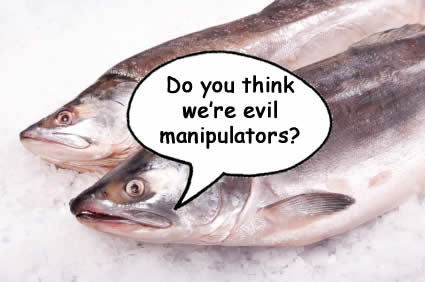It’s the Product, Stupid

The poll I ran earlier this week in Is Your Brand Evil produced results that, in retrospect, were predictable. Fully half the respondents thought that branding could be used in either good or bad ways. Of the other half, my neuromarketing-oriented readers came down four-to-one on the “good” side of branding. I’m sure if I polled a consumerist population the divide wouldn’t have been so lopsided. (The poll is still open, so the current breakdown may vary.) Many so-called consumerists allege brands exist purely to get consumers to buy stuff they don’t need or pay more for the stuff they do need.
I set up the poll after reading Martin Lindstrom’s engaging new book, Brandwashed, in which he reveals a variety of techniques marketers use to appeal to the emotions and subconscious mind of consumers. I probably should have structured the choices differently – after all, just about anything can be good or bad. Water is essential to life and generally benign, but it can still drown you. Branding to enhance a great product or service and communicate its merits to consumers is good. Branding that enhances customer satisfaction with the product is good. Branding that pushes out a product that doesn’t work or that the customer hates is bad. (I’d add that despite the consumer-oriented thrust of his book, I’m not lumping brand development expert Lindstrom into the rabid consumerist category – he clearly sees all sides of the branding issue.)
It’s not about the branding process
I’m sure if I conducted a focus group with the poll-takers who said that branding could be good or evil, there would be agreement that the “evil” use is to misrepresent a product or service, or to convince consumers to buy something they won’t be happy with. It’s not unlike in-person sales. Most sales professionals seek to help their customers solve problems, but a few will say anything to close the sale. The unethical salesperson will misrepresent the product, make promises about performance or delivery that won’t be kept, manipulate the customer’s emotions… all to get the customer to buy immediately. Just about everyone would find that to be evil, even if most salespeople are honest and eager to help. Branding is no different.
Strong brands are authentic
We know how powerful brands are, and, fortunately for consumers, there’s a barrier to evil use of the most powerful brands. That check on branding power is that truly powerful brands aren’t built just by a clever marketing campaign. Rather, they depend on the initial and ongoing customer experience for their strength. Brands like McDonalds, Coca Cola, Toyota, and Whole Foods do have a hold on consumer brains, but that has been built over time and repeated experience. If the products or services backed by a brand are inconsistent with the brand’s image, customer beliefs will change quickly and the brand’s power will be diminished.
As an example of the vulnerability of strong brands, even icons like Coke and Toyota have suffered when their products failed to live up to consumer expectations. To their credit, both firms reacted quickly when they saw what was happening, and the brands remain strong. Some of the most evocative brands are luxury names, and their owners are constantly striving to maintain high product quality and an upscale customer experience. Christian Dior almost destroyed their brand a couple of decades ago when, in pursuit of higher revenues, they spread their brand too broadly. Both product quality and the retail experience suffered, and upscale consumers began to abandon their products. The value of the Dior brand was saved when management reined in distribution and reset high expectations for quality.
Whole Foods, whole fish
In Brandwashed, Lindstrom describes some of the techniques Whole Foods uses to prime shoppers with the idea of freshness: masses of cut flowers, a flowing water feature, not-really-for-sale products like whole fish displayed on beds of ice, and more. Is this evil manipulation? The answer to that question lies in the products. If the actual seafood sold to customers is on the verge of spoilage, then one can argue that anything the store does to sell them is wrong. Selling bad fish would be wrong in and of itself, merchandising gimmickry aside. But, if the fish on sale are fresh and wholesome, then communicating that to shoppers by every means possible is hardly manipulative. Indeed, we know enough about how expectations shape customer experience that one could argue that freshness cues in the store will make the fish taste better at home!
In the long run, brands are only as strong as the products and services they represent. Consumers may be fooled once or twice if they buy based on the logo but are disappointed; then, they will abandon the brand. On the plus side, when brands represent products that meet or exceed expectations, strong brand associations may actually improve the customer experience. In those cases, consider me happy to be “brandwashed.”
